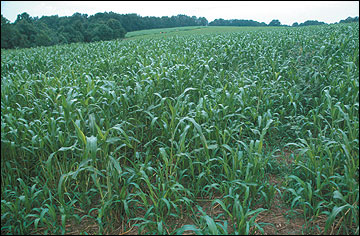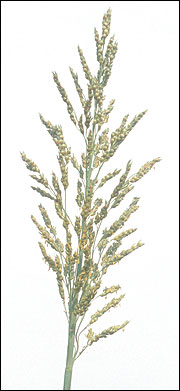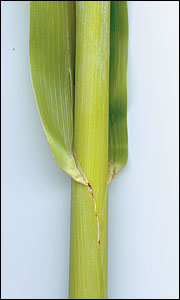Sorghum-sudangrass (Sorghum bicolor (L.) Moench)
Warm-season grasses
Sorghum-sudangrass is a warm-season annual hybrid developed by crossing tall, stemmy sorghum with leafy sudangrass. It is adapted statewide for summer grazing and is well-suited for growing in drought conditions. Sorghum-sudangrass can produce 8,000 to 16,000 lb/acre of dry matter when harvested to a 6- to 10-inch stubble after accumulated growth reaches a height of 24 to 36 inches. It also responds well to split applications of nitrogen at establishment and then again after the first grazing. However, sorghum-sudangrass sometimes produces toxic levels of nitrate and prussic acid, both of which are aggravated by drought and frost. It is less tolerant of acid soils than pearlmillet and prefers levels of 5.5 or higher.
 Sorghum-sudangrass
Sorghum-sudangrass
 Yield distribution of Sorghum-sudangrass in Missouri.
Yield distribution of Sorghum-sudangrass in Missouri.
- Origin: Northeast Africa
- Adaptation to Missouri: Statewide
- Growth habit: Tall, erect, annual.
- Blade: Waxy and glabrous, conspicuous midrib, flat, sharp-pointed, rolled in bud, margins scabrous.
- Sheath: Glabrous, compressed, keeled, shorter than the internodes, open.
- Ligule: Tall, (1/20 to 1/5 inch) abrupt, ciliate, jagged tipped, wider than sheath.
- Auricles: Absent.
- Seed head: Loose, open, erect, panicle with numerous branches.
- Fertilization: 60 lb N/acre at establishment. Thereafter, apply 40 to 60 lb N/acre after each cutting or grazing. Phosphorus and potassium to soil test.
- Timing of production: 90 percent of production occurs in June, July and August.
- When to begin grazing: When grass reaches 24 inches in height. (Note: To avoid prussic acid, do not graze when grass is shorter than 18 inches. It is also best to delay grazing for 14 days after frost or drought stress.)
- When to cut for hay: When it reaches 30 to 36 inches in height.
- Lowest cutting or grazing height: 8 inches

